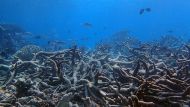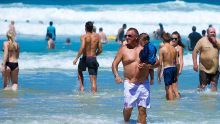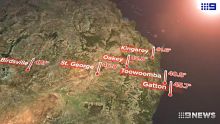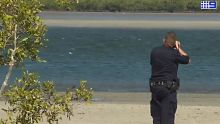Unusually warm sea temperatures and the prospect of more to come have reef scientists worried that the Great Barrier Reef may experience another major coral bleaching event. Sydney's corals may also be at risk.
The reef suffered its worst recorded bleaching event on record last year with some regions losing more than 80 per cent of their coral. Early signs point to a return of bleaching near the Palm Islands, north-west of Townsville.
More QLD News Videos
Video shows mass coral bleaching of Great Barrier Reef
New footage shows the bleak aftermath of the extreme underwater heatwave last summer on the northern region of the Great Barrier Reef, from Researchers at the ARC Centre of Excellence for Coral Reef Studies.
"Currently we're seeing abnormal, widespread but relatively modest levels of bleaching," said Terry Hughes, the Townsville-based director of the ARC Centre of Excellence for Coral Reef Studies. "We'll know in a week or two if another major event is unfolding."
For the second year in a row, the Queensland region is yet to be hit by a tropical cyclone this far into the season. These tempests typically lower sea-surface temperatures by drawing heat from the ocean, mixing in cooler waters, and bringing in more cloud cover and rain.
"The temperatures won't peak until March, so it will come down to whether we have one or more heatwaves, or a cyclone to cool down the [Great Barrier] reef," Professor Hughes said.
Without such storms, the corals face a deadly brew should temperatures exceed certain threshholds. If they do, corals expel the zooxanthellae algae living in their tissues that provide as much as 90 per cent of the energy they need to grow and reproduce, draining them of colour and also increasing mortality.
Greg Torda, an ecologist based at the centre posted early pictures of the bleaching on Twitter, noting that, unlike last year, 2017 is not starting in the midst of an El Nino event that typically raises bleaching risks.
Is this the beginning of the next mass #coral bleaching on the #GBR? In a neutral ENSO year. @JCUOIRS @CoralCoE @aims_gov_au @gbrmarinepark pic.twitter.com/CKnhPaTxsi
— Greg Torda (@DrGregTorda) February 14, 2017
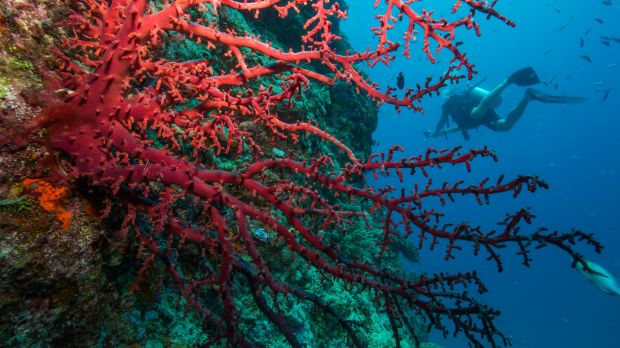
In a follow-up comment, Dr Torda tweeted that the bleaching he witnessed was on the "back reefs of Pelorus and Orpheus, affecting many species. Looks bad".
Fairfax Media has sought comment from the Great Barrier Reef Marine Park Authority.

Reef mortality
Coral bleaching affected much of the Great Barrier Reef last year, particularly north of Cairns. The region north of Cairns has had 11-83 per cent coral mortality.
The bleaching drew international attention to the health of the reef and also stoked opposition to development plans for the state including the potentially massive coal mines of the Galilee Basin.
Burning the coal produced in the mines would not only add to global warming but also trigger a huge increase in shipping activity, opponents say. The mines have the backing of the state and federal governments which claim thousands of jobs will be generated and the coal will help ease poverty in places such as India.
The prospect of more bleaching, though, may reignite those debates. According to the US National Oceanic and Atmospheric Administration, eastern Australia waters are unusually warm, adding to the risk of bleaching. (See NOAA chart below showing warning alerts and areas that are most at risk.)

Susceptible corals
Current readings suggest waters are only moderately warmer than average along the Queensland coastline, with temperatures about one degree warmer than usual. (See Weatherzone chart below, based on NOAA data.)
Andrew Baird, a reef ecologist also at the James Cook University centre in Townsville, said that while research on corals' ability to recover from an event like last year's, it was reasonable to assume some species would be susceptible if temperatures rose again so soon to dangerous thresholds.
"It can take two years for egg quality and fecundity [of corals] to recover," Professor Baird said.

Unusual warmth
While cyclones may bring relief in coming months, recent air and sea temperatures have been abnormally warm. Townsville, for instance, was "baking" in 37-degree heat on Tuesday, he said. That reading is about six degrees above average for February, according to Bureau of Meteorology data.
The bureau's own forecasts point to a couple of more months of warmer-than-usual waters. (See chart below showing predicted temperature anomalies for coming months, in degrees.)

Sydney and NSW
While the Great Barrier Reef's corals will draw much of the attention if bleaching returns, reefs off NSW coast or even in Sydney Harbour may face a more immediate threat.
Professor Baird noted that hotspots in terms of water temperature anomalies were greater than Queensland, potentially affecting the harbour's corals - which suffered their first recorded bleaching last year.
Sea temperatures off Sydney have touched 26 degrees in recent days, according to the Beachwatch website. The city is also in the midst of what's increasingly likely to be its hottest summer on record, and NSW broke its record average state-wide maximum temperature two days in a row.
Weatherzone's chart below, also based on NOAA data, indicates temperatures are more than 3 degrees warmer than average off parts of the NSW south coast.

Also at risk were corals near Lord Howe Island, where some rare species could face particular threat, said Professor Baird, who has recently been documenting another new species there.
"If the bleaching at Lord Howe Island is bad, we'll see extinctions," he said.
Last year's El Nino helped drive global temperatures to an annual record for the third year in a row. While the conditions in the Pacific had shifted back to more neutral conditions, worldwide temperatures have not eased much.
The Japan Meteorological Agency overnight declared last month to be the second-hottest January in records going back to 1891. Sea- and land temperatures were 0.39 degrees above the 1981-2010 baseline it uses, pipped only by January 2016's 0.52-degree anomaly, the agency said.
The big El Nino boosted temperatures by 0.12 degrees in 2016, building on the background warming from climate change to make it the hottest year on record, NASA said last month.


